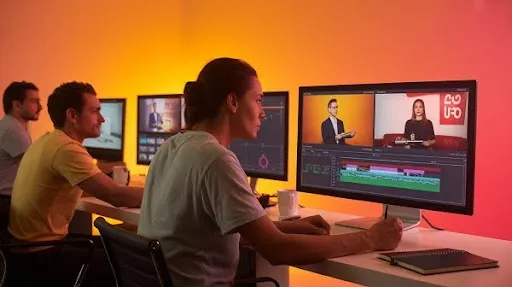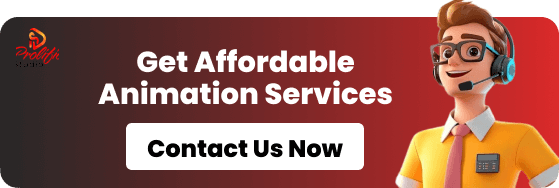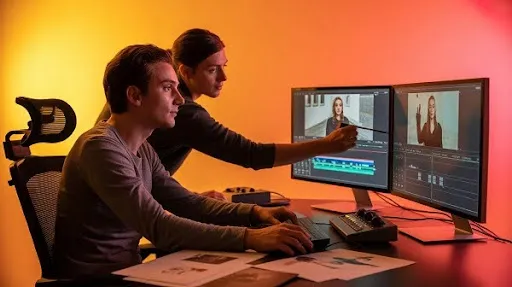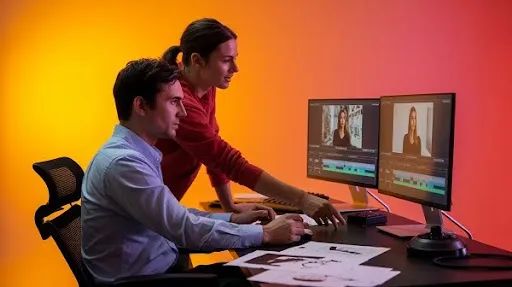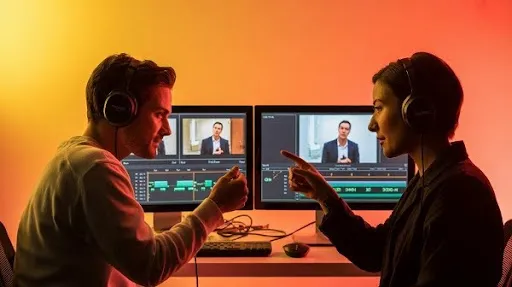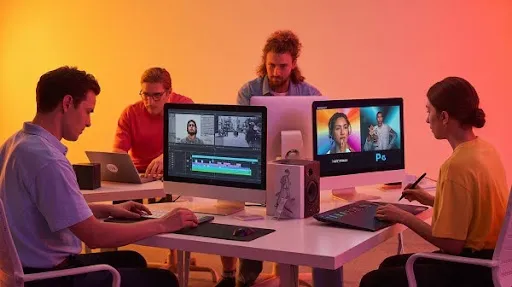Some videos are just watched. Others actually sell. That’s the difference between content that entertains and content that drives results. A VSL in marketing hits that spot perfectly. It’s not just a video, it’s a sales letter in motion.
It transforms your message into something that prompts viewers to take action. Numerous companies invest thousands in websites, advertisements, and social media updates. Few realize the raw selling power of a video sales letter.
When done right, it bridges the gap between interest and purchase. It can lift your VSL conversion rate far beyond static content. So why are VSLs so effective? How can your brand harness them for results? Let’s explore.
What is a VSL and Why It Matters
A VSL stands for a Video Sales Letter. It’s a video that guides viewers through a sales presentation, similar to a written letter but enhanced with visuals, narration, and additional elements.
A strong VSL in marketing combines three elements:
- Emotional storytelling that grabs attention.
- Visual cues that reinforce the message.
- Clear calls to action that push viewers to respond.
When asked, “What is a VSL?” it’s this mix of psychology, video, and marketing copy that converts viewers into buyers. Think of a VSL as a salesperson who never rests.
While your team sleeps, your VSL video keeps persuading and selling. At Prolific Studio, we’ve seen one well-crafted VSL outperform entire ad campaigns. The right tone, visuals, and marketing video script make all the difference.
Why Brands Choose VSL Marketing
Attention spans are shrinking. Buying intent still exists. The challenge is to catch it before it fades. VSL marketing makes that possible. Unlike standard explainer videos, a sales letter video doesn’t just inform.
It persuades. It employs video storytelling methods to create emotional connections, address challenges, and motivate viewers to participate. What factors lead to the popularity of VSLs?
- Humanizes your pitch. Voice, visuals, and expression show value.
- Simplifies complex ideas. A software demo or 3D product animation service becomes clear.
- Boosts conversions. A well-planned VSL funnel can double or triple results versus text-only campaigns.
- Builds trust fast. Seeing and hearing create credibility. Testimonials or a brand mascot strengthen belief.
Anatomy of a High-Converting VSL
Every effective VSL video has a rhythm. It’s structured persuasion, not random storytelling.
1. The Hook
The initial 10 seconds determine whether audiences remain. An effective hook might be a daring assertion, an inquiry, or an unexpected piece of information.
2. Introduction
Set the stage quickly. Inform the audience about your identity, the reasons they should pay attention, and the benefits they will gain. Make it brief.
3. Storytelling
Use brief, relatable stories. Show life before and after your solution. Explainer video marketing can make this visual.
4. Problem Identification
Identify what frustrates your audience. Let them feel understood before offering a solution.
5. Presenting the Solution
Introduce your product as the hero. Highlight benefits. Show proof using 3D product animation services or demos.
6. Building Credibility
Use social proof, expert mentions, awards, and real success stories. This strengthens trust.
7. Value Proposition
Explain what makes your offer different. Focus on benefits, not features. Help viewers visualize the outcome.
8. Call to Action (CTA)
Include mini CTAs in sections. Close with a strong CTA like “Book a call,” “Try today,” or “Get your quote.” A clear, effective video CTA converts interest into action.
9. Scarcity & Urgency
Encourage action with limited-time offers, early-bird bonuses, or exclusive access.
10. Closing & Reinforcement
Wrap up with a recap. Repeat the CTA. Give viewers a confident reason to act now. Execution is key. Professional VSL video production ensures crisp editing, pacing, and messaging.
The VSL Creation Process
At Prolific Studio, every high-converting VSL follows a step-by-step process.
Step 1: Define the Purpose
Start with a goal. Are you promoting a service, generating leads, or launching a product? The tone and format depend on it.
Step 2: Know the Audience
Identify your ideal viewer. Understand their pain points, expectations, and objections. This forms the emotional base of your VSL.
Step 3: Write the Script
The VSL script is your invisible salesman. It should sound natural and persuasive. We use sales video script writing to build tension and resolution. This keeps viewers engaged.
Step 4: Visual Storyboarding
Visuals support the script. Utilize 3D animation services, motion graphics, or 3D product configuration to effectively display what they will receive.
Step 5: Voice & Tone Selection
Voiceovers are your brand’s personality. The right voice, pace, and tone (using voice generation in animation) bring the message alive.
Step 6: Production
Sound design, animation, color grading, and pacing come together here. Every beat maintains engagement and fits your sales funnel video.
Step 7: Optimization & Launch
Before launch, test and refine. Short cuts for ads, captions for social platforms, and thumbnail tests all improve video content optimization.
Why VSLs Beat Traditional Sales Pages
Text-based pages work for SEO but lack emotion. A VSL in marketing builds connection and trust faster. Adding a VSL video to a landing page boosts time-on-page. Viewers stay longer, listen, and understand your offer.
That’s why video landing page optimization is important. Unlike text, a VSL blends visuals, testimonials, and emotion in one place. It becomes a true customer conversion video. Brands also benefit from repurposing content. Full-length sales videos can become social clips, stories, or explainer video segments.
How to Make Your VSL Work
Making a VSL is one thing. Making a VSL that actually makes someone act? That’s a completely different story. An engaging video captures interest, maintains viewer involvement, and encourages decision-making, all while remaining subtle. Let’s dissect the process of achieving that.
Grab Attention Fast
The first few seconds are everything. If viewers aren’t interested right away, they scroll past.
- Start with a bold statement, question, or surprising fact.
- Share a tiny story that sparks curiosity.
- Even a single line that makes someone pause can change everything.
The key is to make people stop and say, “Wait, what’s this?”
Keep Stories Short
People don’t have time for long explanations. Short, relatable stories win.
- One or two sentences can show a clear transformation.
- Use examples people can immediately understand.
- Make the benefit obvious in the first moments.
Short stories stick in memory. They’re easier for people to digest.
Show Proof, Not Just Claims
Words alone aren’t enough. You need evidence.
- Use screenshots, demos, or animations.
- Include testimonials or statistics when possible.
- Tools like 3D product animation services make complex ideas simple.
When people see proof, they believe it. That builds trust fast.
Speak Naturally
The voiceover is your personality. Skip robotic narration.
- Keep the tone human and relatable.
- Match your audience, friendly, confident, or energetic.
- Pause naturally. Don’t rush.
A natural voice keeps viewers watching. A stiff voice makes them leave.
Repeat the Call to Action
Viewers forget. A single reminder isn’t enough.
- Sprinkle mini prompts throughout the video.
- End with a clear instruction: “Sign up today,” “Book a demo,” or “Try it now.”
- Even tiny tweaks, a word, a thumbnail, can improve results.
Writing Scripts That Work
The script is your foundation. Without it, the video can’t convert.
- Start with emotion. Show a problem or desire your audience has.
- Demonstrate transformation. Before-and-after examples work well.
- Keep language simple and sentences short.
- Add proof, stats, testimonials, demos.
- End clearly. Tell viewers what to do next.
A good script entertains, informs, and nudges people toward action.
Visual Storytelling
Video is visual. Words alone can’t sell.
- Use motion graphics to highlight key points.
- Product animations show how things actually work.
- Colors and lighting set the mood and guide the eye.
- Cutaways combine demos with real-life examples.
- Text overlays make info easy to follow.
Every visual should help the story, not distract from it.
Voiceover and Tone
Your voiceover is more than narration; it’s your personality in audio form.
- Pace matters. Too fast is rushed, too slow is boring.
- Emotion drives engagement. Monotone is a no-go.
- Be consistent. Match your brand tone across videos.
A natural, emotional voice can hold attention until the very end.
Production Tips
Good production matters, but you don’t need Hollywood money.
- Keep edits smooth and clean.
- Music should enhance, not distract.
- Match fonts, colors, and visuals to your brand.
- Test early. Short clips reveal what works.
- Scenes should flow naturally.
Even small improvements can boost engagement.
Repurposing Your VSL
One video can serve multiple purposes. This saves time and increases ROI.
- Landing pages. Keep viewers engaged where conversions happen.
- Social media. Break it into clips, stories, or reels.
- Email campaigns. Videos increase clicks and interest.
- Paid ads. Highlight the best hook for attention.
- Webinars or presentations. Use your VSL as a visual guide.
Repurposing lets one video work harder.
Common Mistakes
Even good VSLs fail if the basics are ignored:
- Too long. Keep it 3–5 minutes.
- Too many ideas. Focus on one message.
- No proof. People want evidence.
- Weak CTA. Tell viewers exactly what to do.
- Ignoring mobile. Most watch on phones, format accordingly.
Fixing these early saves headaches later.
Optimizing Landing Pages
Your VSL works best on a strong landing page.
- Put the CTA above the fold. Don’t make people scroll.
- Minimize distractions. Keep links limited.
- Use testimonials or logos for credibility.
- Make sure it plays smoothly on mobile.
- Test thumbnails, they can increase clicks by 20–30%.
A good landing page multiplies the impact of your video.
Testing and Analytics
Even after publishing, you need to track results.
- Check how many people watch to the end.
- Look at CTA clicks, are people acting?
- Find drop-off points. Where do viewers leave?
- Run A/B tests for hooks, visuals, and CTAs.
- Iterate and improve continuously.
Data keeps your VSL effective and converting.
Frequently Asked Questions
What is a VSL and why use it?
A VSL is a video combining visuals, voice, and storytelling. It often converts better than text alone.
How long should a VSL be?
3–5 minutes is ideal. Only go longer if the content truly requires it.
Can I use a VSL on social media?
Yes. Break it into clips, stories, or reels. Hook viewers fast.
Do I need 3D product animation?
Not always. But it can help explain complex products and build trust.
What makes a VSL high-converting?
Strong hooks, storytelling, proof, clear CTAs, and subtle urgency.
How to measure success?
Track watch time, drop-offs, CTA clicks, conversions, and engagement.
Can VSLs replace sales pages?
Yes. A good VSL often outperforms text pages by combining proof, clarity, and emotion.
Conclusion
A VSL is like a salesperson that never sleeps. A strong VSL:
- Captures attention immediately
- Connects emotionally
- Shows proof and builds trust
- Guides viewers to act
Clarity, organization, and simplicity are extremely essential. Brief stories, visual proof, regular prompts, and trials establish the difference.
Transform your video for various platforms to enhance ROI. A single VSL can generate leads, sales, and engagement much more effectively than conventional campaigns.
Mastering VSL marketing turns interest into action. Think of it as investing in a silent, persuasive salesperson who works 24/7.
Related Articles:

